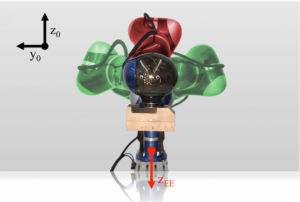![]() Nico Mansfeld, Badis Djellab, Jaime Raldúa Veuthey, Fabian Beck, Christian Ott, and Sami Haddadin Improving the Performance of Biomechanically Safe Velocity Control for Redundant Robots through Reflected Mass Minimization
Nico Mansfeld, Badis Djellab, Jaime Raldúa Veuthey, Fabian Beck, Christian Ott, and Sami Haddadin Improving the Performance of Biomechanically Safe Velocity Control for Redundant Robots through Reflected Mass Minimization
IEEE/RSJ International Conference on Intelligent Robots and Systems (IROS) 2017

Abstract
Ensuring safety is a primary goal in physical human-robot interaction. In various collision experiments it was found that the robot’s effective mass, velocity, and geometry are the key parameters which influence the human injury severity during an impact. Recently, a velocity controller was proposed that limits the robot speed to a biomechanically safe value, taking into account the mass and the curvature in the direction of movement for a given point of interest. The mass and the geometry depend on the mechanical design, however, the effective mass also depends on the robot configuration. In this paper, we exploit the redundant degree(s) of freedom of a joint torque controlled seven- and eight-DOF robot to minimize the effective mass without affecting the desired Cartesian end-effector trajectory and with the goal to improve the performance of the safe velocity controller at the same time. Given recent results in robotics injury analysis, we analyze when such a redundancy resolution scheme actually improves safety. For the considered robots, we find reflected mass extrema that can be obtained by null space motions, and propose a real-time, torque-based redundancy resolution scheme, which is finally verified in experiments.
@INPROCEEDINGS{8206435,
author={N. Mansfeld and B. Djellab and J. R. Veuthey and F. Beck and C. Ott and S. Haddadin},
booktitle={2017 IEEE/RSJ International Conference on Intelligent Robots and Systems (IROS)},
title={Improving the performance of biomechanically safe velocity control for redundant robots through reflected mass minimization},
year={2017},
volume={},
number={},
pages={5390-5397},
keywords={collision avoidance;end effectors;geometry;human-robot interaction;manipulator dynamics;minimisation;mobile robots;motion control;path planning;redundant manipulators;torque control;velocity control;Cartesian end-effector trajectory;biomechanically safe value;biomechanically safe velocity control;collision experiments;given recent results;human injury severity;mass extrema;physical human-robot interaction;redundant degrees of freedom;redundant robots;reflected mass minimization;robot configuration;robot effective mass;robotics injury analysis;safe velocity controller;torque control;torque-based redundancy resolution scheme;Collision avoidance;Injuries;Minimization;Null space;Robot kinematics;Safety},
doi={10.1109/IROS.2017.8206435},
ISSN={},
month={Sept},
}
